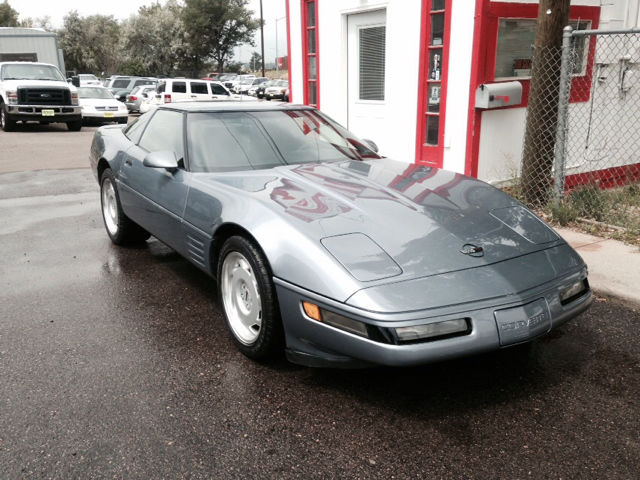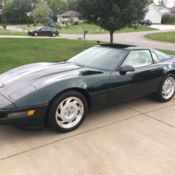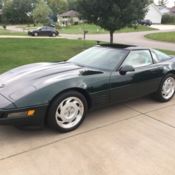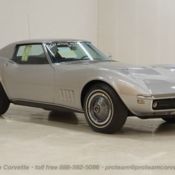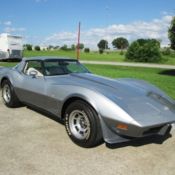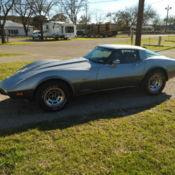1991 CHEVY CORVETTE 63K ACTUAL DOC. MILES A/T SILVER SPRUCE ABSOLUTE SALE BIDNOW
1991 Chevrolet Corvette BASE LT1
Thank you for looking at my 1991 Chevy Corvette for sale actual documented miles very clean very well kept clean oil great running full of power up for best offers, this vette has all the options available in 1991 leather power auto air defrost abs and optional paint. I prefer the the automatics so that's what I seek. No leaks tears or rips battery in great shape tires are dry but have abundant tread. clean history well kept rims do not have rash no real damages fun to own easy cheap thrills. thanks for looking if I can answer any of your questions please call thanks TREVOR.VERY CLEAN NO ISSUES CALL TODAY 720-840-9731 WITH QUESTIONS
Chevrolet Corvette (C4)
| 1996 Chevrolet Corvette Coupe |
| Chevrolet (General Motors) |
| 1983–1996 |
| 1984–1996 |
| United States: Bowling Green, Kentucky |
| Sports car |
|
| FMR layout |
| Y-body |
|
|
|
| 96.2in (2,440mm) |
| 176.5in (4,480mm) (1984–1989) |
| 71.0in (1,800mm) (1984–1992) |
|
| 3,239lb (1,469kg) |
| Chevrolet Corvette (C3) |
| Chevrolet Corvette (C5) |
The Chevrolet Corvette (C4) is a sports car that was produced by Chevrolet for the 1984 through 1996 model years. The convertible returned, as did higher performing engines, exemplified by the 375hp (280kW) LT5 found in the ZR-1. In early March 1990, the ZR-1 would set a new record for the highest 24 hour-5,000 mile land-speed by going over 175mph (282km/h).[1] Though prices rose even as sales declined, the fourth generation Corvette won its own loyal following as one of the United States' most desirable sports cars. The last C4 was produced on June 20, 1996.[2]
Contents- Overview
- ZR-1 (1990–1995)
- 2.1 ZR-1 Active Suspension prototype (1990)
- B2K Callaway Twin-Turbo
- Special editions
- 4.1 Pace Car Convertible
- 4.2 35th Anniversary
- 4.3 40th Anniversary
- 4.4 Brickyard 400 Festival/Parade Car
- 4.5 Indy Pace Car
- 4.6 Grand Sport
- 4.7 Collector Edition
- Production notes
- Engines
- Concept cars
- 7.1 CERV III
- 7.2 ZR2
- Racing
- 8.1 Corvette GTP (IMSA)
- Le Mans
- See also
- References
- Further reading
- External links
The C4 Corvette was known for its evolved, sleek and modern look. In a departure from the fiberglass panels of its forebearers, the C4's rear bumpers and panels were made from molding plastics, a sheet molding compound. The C4 coupe was the first general production Corvette to have a glass hatchback (the limited edition 1982 Collectors Edition being the first Corvette equipped with this feature) for better storage access. The Corvette C4 came standard with an electronic dashboard with a digital liquid crystal display dash, with graphics for speed and RPM and digital displays for other important engine functions.
1984 Corvette CoupeThe C4 represented a clean break from the previous generation of Corvette with a completely new chassis and modern, sleeker styling. Since emissions regulations were still changing and electronic engine management was in its infancy, horsepower was, compared to earlier generations, low. Therefore, the primary design emphasis, at least for the launch, was on handling and braking, with all-independent suspension with light-weight suspension and wheels, and all new brakes with aluminum calipers. The front suspension saw the C3's coil springs replaced by a transverse fiberglass mono-leaf spring, which was only 1/3 of the weight of the coil springs while also introducing an anti-roll bar-like effect on the front.[3] The price of this no-holds-barred emphasis on handling was ride comfort, especially with the Z51 performance and handling package. The C4 did not use separate body-on-frame construction like its predecessors. Instead, it used what GM termed a "uniframe", which consisted of a traditional perimeter frame, with the door posts, windshield frame, halo, and the rear portion of the floor pan integrated into one welded assembly. This was not a unibody assembly, as none of the exterior body panels were structural members. Due to a styling decision to use a targa top instead of T-tops, there was no structural member tying the windshield frame to the halo as on the C3. This required extremely tall side rails on the frame to maintain chassis rigidity, and as a result, the door sills were quite deep, with entry and exit likened by contemporary auto journals to a "fall in and climb out" experience. The targa top bolted into place, becoming a structural component, rather than simply latching on like T-tops. Despite the tall frame rails, the C4 was prone to rattles and squeaks, especially with the targa top removed. The emergency brake, located between the door sill and the drivers seat, was moved lower and toward the rear of the car in 1988 for easier entry and exit.
From 1984 through 1988, the Corvette was available with a Doug Nash "4+3" transmission - a 4-speed manual coupled to an automatic overdrive on the top three gears. This unusual transmission was a synergy that allowed Corvette to keep a stout 4 speed, but add an overdrive. As technology progressed, it was replaced by a modern ZF 6-speed manual. However, the C4 performance was hampered by its L98 250hp (186kW) engine until 1992, when the second-generation Chevy small block, LT1, was introduced, markedly improving the C4s performance. 1996 was a high point of small block Chevrolet development and the 330hp (246kW) LT4 was introduced in all six-speed manual transmission cars. The LT4 achieved a 30hp gain over the LT1 and top the dyno scales at 330 hp at 5,800 rpm and 340 lb-ft of torque at 4,500 rpm. While the LT4 was available in any Corvette, it was highlighted in the '96 Grand Sport package.[4]
The 1986 Corvette saw the reintroduction of the convertible and was named as the Pace Car for the Indianapolis 500. 1986 also saw the introduction of the Pass Key I passive anti-theft system, wherein each key contained a special pellet that could be detected and identified by the car's computer system by detecting electrical resistance. Being early in the rollout of this new technology, there were only 15 different resistance values available, which, once thieves discovered this weakness, markedly reduced the value of this early system.
44 Corvettes were manufactured with a 1983 Vehicle Identification Number (VIN), but none were released to the public as official production vehicles. All were destroyed except one, VIN 1G1AY0783D5100023 (white with medium blue interior), L83 350cuin (5.7L), 205hp (153kW) V8, 4-speed automatic transmission and was retired to the National Corvette Museum in Bowling Green, Kentucky. (MY1984 Corvettes were produced for 17 months.)
ZR-1 (1990–1995) 1990 Corvette ZR-1 5.7L (350cuin) LT5 V8 in a C4 ZR-1 1995 Corvette ZR1 Window StickerDuring 1986, General Motors acquired Group Lotus, the UK based engineering consulting and performance car manufacturing firm. The Corvette division approached Lotus with the idea of developing the world's fastest production car, to be based on the C4 generation Corvette. With input from GM, Lotus designed a new engine to fit in place of the L98 V8[citation needed] that was powering the standard C4. The result was what GM dubbed the LT5, an aluminum-block V-8 with the same bore centers as the L98, but with four overhead camshafts, 32 valves. Lotus also designed a unique air management system for the engine to provide a wider power band by shutting off 8 of the 16 intake runners and fuel injectors when the engine was at part-throttle, while still giving the ZR-1 375hp (280kW) when at wide open throttle. In addition to the engine, Lotus helped GM design the ZR-1's (which in prototype version was called "King of the Hill"[5]) upgraded braking and steering systems[citation needed], and helped them pick the settings for the standard "FX3" adjustable active ride control that Chevrolet was fitting to the car[citation needed], helping to ensure that the vehicle was more than just a modern-day muscle car with a big engine and no real capability on the track.
GM found that the engine required special assembly, and that neither the Corvette plant in Bowling Green, Kentucky nor any of their normal production facilities could handle the workload, so Mercury Marine corporation of Stillwater, Oklahoma was contracted to assemble the engines and ship them to the Corvette factory in Bowling Green where the ZR-1s were being assembled.
The vehicle went on sale in 1990 and was available only as a coupe. It was distinguishable from other Corvette coupes by its wider tail section, 11" wide rear wheels and its new convex rear fascia with four square shaped taillights and a CHMSL (center high mounted stop lamp) attached to the top of the hatch glass instead of between the taillights.
The ZR-1 displayed stunning ability both in terms of acceleration and handling capabilities, but carried with it an astonishingly high price. MSRP for the (375hp) ZR-1 in 1990 was $58,995,[6] almost twice the cost of a (250hp) non-ZR-1,[7] and had ballooned to $66,278 by 1995; some dealers successfully marked units as high as $100,000. Even at base MSRP, this meant that the ZR-1 was competing in the same price bracket as cars like the Porsche 964, making it a hard sell for GM dealers.
1992 Corvette ZR1In 1991, the ZR-1 and base model received updates to body work, interior, and wheels. The rear convex fascia that set the 1990 ZR-1 apart from the base model found its way to all models, making the high-priced ZR-1 even less distinguishable. Further changes were made in 1992, including extra ZR-1 badges on the fenders and the introduction of Acceleration Slip Regulation (ASR) or traction control. For model year 1993, Lotus design modifications were made to the cylinder heads, exhaust system and valvetrain of the LT5, bringing horsepower up from 375 to 405. In addition, a new exhaust gas recirculation system improved emissions control. The model remained nearly unchanged into the 1995 model year, after which the ZR-1 was discontinued as the result of waning interest, development of the LS series engines, cost and the coming of the C5 generation. A total of 6,939 ZR-1s were manufactured over the six-year period. Not until the debut of the C5 platform Z06 would Chevrolet have another production Corvette capable of matching the ZR-1's performance.
Although the ZR-1 was extremely quick for its time (0-60mph in 4.4 seconds, and onto 180+ mph), the huge performance of the LT5 engine was matched by its robustness. As evidence of this, a stock ZR-1 set seven international and world records at a test track in Fort Stockton, Texas on March 1, 1990, verified by the FIA (Fédération Internationale de l'Automobile) for the group II, class 11 category:[8] [9]
- 100 miles (160km) at 175.600mph (282.601km/h)
- 500 miles (800km) at 175.503mph (282.445km/h)
- 1,000 miles (1,600km) at 174.428mph (280.715km/h)
- 5,000km (3,100mi) at 175.710mph (282.778km/h) (World Record)
- 5,000 miles (8,000km) at 173.791mph (279.690km/h) (World Record)
- 12 Hours Endurance at 175.523mph (282.477km/h)
- 24 Hours Endurance at 175.885mph (283.059km/h) for 4,221.256 miles (6,793.453km) (World Record)
These records were later broken by the Volkswagen W12, a one-off concept car that never went into production.
ZR-1 Active Suspension prototype (1990)It was based on the ZR-1, but it includes active hydraulic suspension found in GTP Corvette race car. It was developed as a prototype for a limited edition run in the 1990 model year.[10]
25 active suspension vehicles were built at the Bowling Green Plant.[11]
A prototype was sold in 2009 at the Barrett-Jackson Palm Beach auction for $60,000 (before buyer premium).[12][13]
B2K Callaway Twin-TurboIn 1987, the factory B2K option appeared at dealers. The option's price was almost equal to the base price of the Corvette.
The Callaway Corvette was a Regular Production Option (RPO) B2K, the only time in Chevrolet's history a specialist manufacturer was entrusted with a technically advanced high performance RPO. The B2K option was critical in bringing a select few Corvettes to a higher performance level. Although often compared with Chevrolet's ZR-1 option, they were simply two different approaches to solving the issue of bringing a higher performance Corvette to market. The early B2K's produced 345hp (257kW) and 450lb·ft (610N·m) of torque. [4] The later B2K's produced 450hp (336kW) and 613lb·ft (831N·m) of torque. [5]
A derivative of the Twin Turbo Corvette, the 880hp (656kW) Callaway SledgeHammer, recorded a speed of 254.76mph (410.00km/h) on Ohio's Transportation Research Center track making it the fastest road-going car at the time.[citation needed]
Special editionsPace Car Convertible 1986 Convertible Indy 500 Pace Car editionA yellow convertible was the pace car for the 1986 Indianapolis 500 race. This marked the return of the convertible body style, absent from the Corvette lineup since 1975. All 7,315 1986 convertible Corvettes (all exterior colors) had "Indy 500 Pace Car" console identification.
35th Anniversary 1993 40th Anniversary ConvertibleThe 1988 35th Anniversary edition, also known as the "Triple White Corvette" is a white Corvette coupe with white wheels and white interior (including seats & steering wheel). It also features a removable black top and came equipped with everything, including its own unique emblems. The 35th Anniversary car is the 2nd Serialized Corvette in its history, with each car receiving an engraved number plaque on the console. There were 2050 cars built and a quoted 180 of these were Manual Transmission cars, making this a rare and collectible Corvette.
In 2009, the Barrett-Jackson’s Palm Beach auction house offered an original, first-owned Z01-optioned 35th Anniversary Corvette with only 682 miles (1,098km). The 350/245 engine was coupled to a rare 4-speed manual transmission (MMF), an option chosen by only 19%. For 21 years, the car was stored in a climate controlled environment. The 35th Anniversary Corvette hammered home for $37,500 and with commission the final sales price was $41,250. This easily beats the high price for a 35th Anniversary edition of $32,100 at an RM Auction held in 1998 in Monterey as listed in the VetteMarket.com database.[14]
40th AnniversaryThe 1993 40th Anniversary package was available on all models. It included Ruby Red metallic paint and Ruby Red leather sport seats, along with special trim and emblems. 6,749 were sold at an additional cost of $1,455. All leather seats have the 40th emblem embroidered due to an error on the drawings sent to the seat supplier.
Brickyard 400 Festival/Parade CarIn 1994 twenty five (25) Corvette Convertibles were delivered to the Indianapolis Motor Speedway for use in the inaugural running of the Brickyard 400. The Corvettes were primarily used to introduce the 43 NASCAR drivers in a parade lap prior to the start of the race during driver introductions. There were thirteen Red and twelve Black convertibles used, and most carried two drivers on the lap, with their names displayed on the hoods. They also carried civil, NASCAR, and Manufacturer dignitaries on other parade laps, people like "the King" Richard Petty and Bobby Allison, and Mayor Goldsmith of Indianapolis. It is unknown how many of these cars still exist in "full dress" since many dealers just removed the graphics when they received the cars after the race.
Indy Pace CarIn 1995 a C4 convertible was again the pace car for the Indianapolis 500, and a special pace car edition was offered. 527 were built.
Grand Sport 1995 Convertible Indy 500 Pace Car editionChevrolet released the Grand Sport (GS) version in 1996 to mark the end of production of the C4 Corvette. The Grand Sport moniker is a nod to the original Grand Sport model produced in 1963. A total of 1,000 GS Corvettes were produced, 810 as coupes and 190 as convertibles. The 1996 GS came with the high-performance LT4 V8 engine, producing 330hp (246kW) and 340lb·ft (461N·m) of torque. The Grand Sport came only in Admiral Blue with a white stripe down the middle, 5-spoke black wheels, two red "hash marks" on the front driver's side wheel arch and special seat trim providing a distinctive look. The Grand Sport also has wider tires and the coupes were outfitted with small rear fender flares.
1996 Grand Sport Collector EditionThe 1996 Collector Edition was the last of the C4 Corvettes, just as the 1982 Collectors Edition was the last of the C3s. It included Sebring Silver paint, silver 5-spoke alloy wheels, and special emblems and seat trim. Of the 5,412 built, 4,031 were coupes and 1,381 were convertibles. It cost $1,250 extra.
Production notes| 1984 | 51,547 | $21,800 | C4 hatchback body is popular. Digital instrumentation is controversial. L83 engine continued from 1982. |
| 1985 | 39,729 | $24,891 | More powerful and fuel efficient L98 engine introduced. |
| 1986 | 35,109 | $27,027 | First convertible since 1975-all 7,315 have Indy 500 pace car console id plaque. New were Third brake light, antilock brakes, electronic climate control, and key-code anti-theft system. |
| 1987 | 36,632 | $27,999 | Callaway twin-turbo offered through dealers with GM warranty. |
| 1988 | 22,789 | $29,480 | New wheel design. All white 35th Anniversary special edition coupe. |
| 1989 | 26,412 | $32,045 | ZF 6-speed manual replaces Doug Nash 4+3. |
| 1990 | 23,646 | $32,479 | ZR-1 is introduced with DOHC LT5 engine. Interior redesigned to incorporate drivers-side air bag. |
| 1991 | 20,639 | $33,005 | Restyled exterior. Last year for the Callaway B2K twin turbo. |
| 1992 | 20,479 | $33,635 | New LT1 engine replaces the L98. Traction control is standard. |
| 1993 | 21,590 | $34,595 | Passive keyless entry is a new standard feature. 40th Anniversary special edition. |
| 1994 | 23,330 | $36,185 | New interior including passenger airbag. LT1 receives mass air flow sequential fuel injection. |
| 1995 | 20,742 | $36,785 | Last year of the ZR-1. Minor exterior restyling. Indy Pace Car special edition. |
| 1996 | 21,536 | $37,225 | Optional LT4 engine with 330hp (246kW). Collectors Edition and Grand Sport special editions. First year with OBD II diagnostics. Selective Real Time Damping is a new option. |
| 5.7L (350cuin) L83 V8 | 1984 | 205hp (153kW) | 290lb·ft (393N·m) |
| 5.7L (350cuin) L98 V8 | 1985–1986 | 230hp (172kW) | 330lb·ft (447N·m) |
| 1987–1989 | 240hp (179kW) | 345lb·ft (468N·m) | |
| 1987 (B2K Callaway) | 345hp (257kW) | 465lb·ft (630N·m) | |
| 1988–1989 (coupes with 3.07 rear) | 245hp (183kW) | 345lb·ft (468N·m) | |
| 1988–1989 (B2K Callaway) | 382hp (285kW) | 562lb·ft (762N·m) | |
| 1990–1991 | 245hp (183kW) | 345lb·ft (468N·m) | |
| 1990–1991 (coupes with 3.07 rear) | 250hp (186kW) | 345lb·ft (468N·m) | |
| 1990–1991 (B2K Callaway) | 403hp (301kW) | 575lb·ft (780N·m) | |
| 5.7L (350cuin) LT5 V8 | 1990–1992 | 375hp (280kW) | 370lb·ft (502N·m) |
| 1993–1995 | 405hp (302kW) | 385lb·ft (522N·m) | |
| 5.7L (350cuin) LT1 V8 | 1992 | 300hp (224kW) | 330lb·ft (447N·m) |
| 1993–1995 | 300hp (224kW) | 340lb·ft (461N·m) | |
| 1996 | 300hp (224kW) | 335lb·ft (454N·m) | |
| 5.7L (350cuin) LT4 V8 | 1996 (with manual transmission) | 330hp (246kW) | 340lb·ft (461N·m) |
In June 1985, Chevrolet Chief Engineer Don Runkle and Lotus' Tony Rudd discussed creating a new show car to show off their engineering expertise. The project would become the CERV III (Corporate Engineering Research Vehicle III). It was first unveiled in Detroit Automobile Show in January 1986 as Corvette Indy prototype car.
ZR2Also called 'Big Doggie', it is a concept model build based on a C4 Corvette, but with a much larger 454ci big block v8 OHV engine with multi-port fuel injection similar to the tuned port injection found on the 5.7L corvette from 85-91 and a 6-speed manual transmission.[15][16]
The vehicle was built by Corvette Development Engineering as a development car to study the possibility of achieving ZR-1 performance while reducing cost by utilizing a big block engine. The engine was rated 400hp.[17]
The prototype vehicle was sold in 2009 at the Barrett-Jackson Collector Car Auction for $65,000.[18]
RacingCorvette GTP (IMSA) Main article: Chevrolet Corvette GTPAs part of GM's initiative to promote the new C4 Corvette, they funded a program in the IMSA GT Championship to run a GTP-class prototype under the Corvette name, mostly run by Hendrick Motorsports. Although the Corvette GTP actually shared very little with the production C4 Corvette, including the lack of a V8* engine in some races, it did use some styling cues. The project lasted until 1988 with mixed success.
Note*:- The final Corvette GTP built (HU8811.01) as raced by Peerless Racing underwent extensive wind tunnel testing by GM, with many of the 'aero' developments (such as the short tail design) being used in later production C4's. The Peerless GTP Corvette also went back to the V-8 small block engine from the turbo V-6. This final GTP Corvette (Peerless) was driven by Hobbs, Baldwin, Villeneuve & Goodyear in IMSA before having the BBC based Eagle (10.2) engine installed to take to Le Mans in 1990.
Le MansThe C4 also made an appearance in international sports car endurance racing in a project orchestrated by former Corvette Cup driver Doug Rippie. The car, based on the ZR1 trim C4, competed in the popular GT1 class in 1995 at Le Mans and Sebring, where it momentarily led http://badboyvettes.com/169 .
See also- Chevrolet Corvette
- Dave McLellan
- Mueller, Mike (2004). "1975-96: Chevrolet's Fiberglass Legacy Rolls On". Corvette. St. Paul, Minnesota: MBI Publishing. ISBN978-0-7603-1968-0.
- Newton, Richard (2003). 101 Projects for Your Corvette 1984-1996. St. Paul, Minnesota: MBI Publishing. ISBN978-0-7603-1461-6.
| Wikimedia Commons has media related to Chevrolet Corvette C4. |
- C4 Vette Registry
- Callaway Twin-Turbo Corvette video
- Chevrolet Corvette
- Cars introduced in 1984
- 1980s automobiles
- 1990s automobiles
- Not logged in
- Talk
- Contributions
- Create account
- Log in
- Article
- Talk
- Read
- Edit
- View history
- Main page
- Contents
- Featured content
- Current events
- Random article
- Donate to Wikipedia
- Wikipedia store
- Help
- About Wikipedia
- Community portal
- Recent changes
- Contact page
- What links here
- Related changes
- Upload file
- Special pages
- Permanent link
- Page information
- Wikidata item
- Cite this page
- Create a book
- Download as PDF
- Printable version
- Wikimedia Commons
- العربية
- Deutsch
- Ελληνικά
- Español
- فارسی
- Polski
- Suomi
- This page was last modified on 2 August 2016, at 04:47.
- Text is available under the Creative Commons Attribution-ShareAlike License; additional terms may apply. By using this site, you agree to the Terms of Use and Privacy Policy. Wikipedia® is a registered trademark of the Wikimedia Foundation, Inc., a non-profit organization.
- Privacy policy
- About Wikipedia
- Disclaimers
- Contact Wikipedia
- Developers
- Cookie statement
- Mobile view
- Condition: Used
- Make: Chevrolet
- Model: Corvette
- SubModel: BASE LT1
- Type: Coupe
- Trim: Base Hatchback 2-Door
- Year: 1991
- Mileage: 63,777
- VIN: 1G1YY2385M5108690
- Color: Blue
- Engine size: 5.7L 350Cu. In. V8 GAS OHV Naturally Aspirated
- Number of cylinders: 8
- Power options: Air Conditioning
- Transmission: Automatic
- Drive type: RWD
- Interior color: Black
- Options: Cassette Player, Sunroof
- Vehicle Title: Clear Want to buy? Contact seller!
